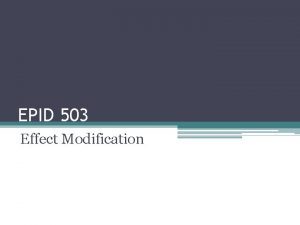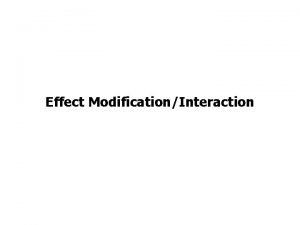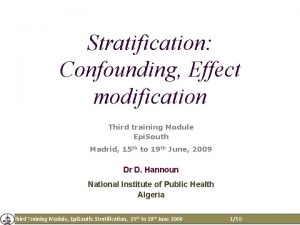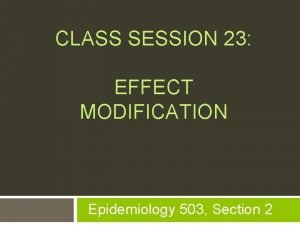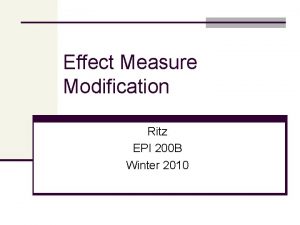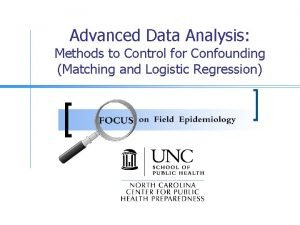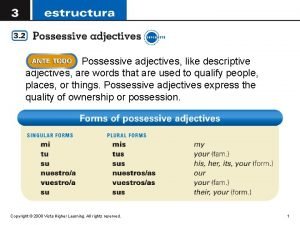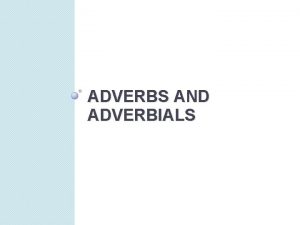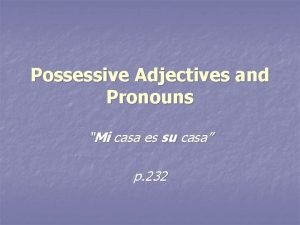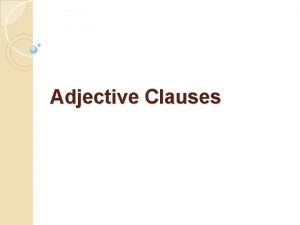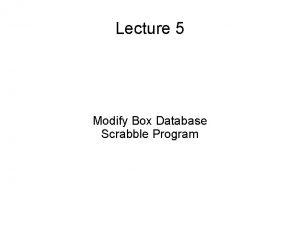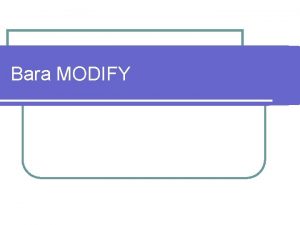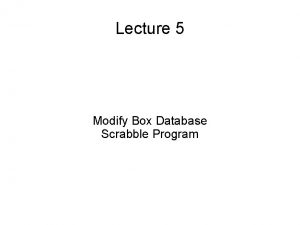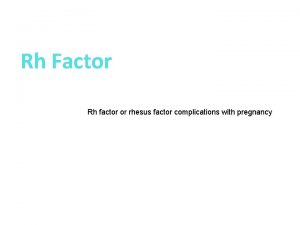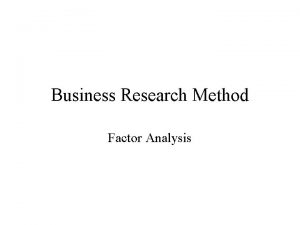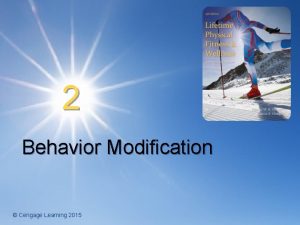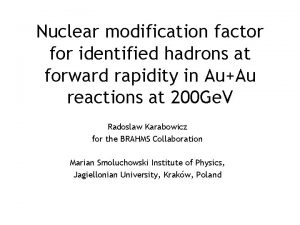Effect ModificationInteraction Effect Modification Factor that modify the


























- Slides: 26

Effect Modification/Interaction

Effect Modification • Factor that modify the effect of an exposure on the outcome. • It is also known as statistical Interaction.

Effect Modification • EM is a biological phenomenon. • Can be compared to the biological concept of synergy

Effect Modification Bookish Language: In epidemiology “effect modification” describes a situation in which two or more risk factors modify the effect of each other with regard to the occurrence or level of a given outcome.

Effect Modification Simple Language: When the incidence rate of a disease in the presence of two or more factors differs from the incidence rate expected to result from their individual effects

Effect Modification Simple Language: • Effect can be greater than what we would expect (positive interaction, synergism), or • Effect can be less than what we would expect (negative interaction, antagonism)

Effect Modification/Interaction Bookish Language If the presence of the effect modifier potentiates the effect of the exposure of interest, then this modifier and the exposure are said to be synergistic (Positive interaction).

Effect Modification/Interaction Bookish Language: If it eliminates or diminishes the effect, then the modifier and the exposure are said to be antagonistic (negative interaction).

Difference with Confounding • Confounding refers to a situation in which variable that is associated with both the exposure and outcome of interest is responsible for the entirety or part of the statistical association between the exposure and outcome. • No biological phenomenon, only spurious/false finding - Confounding

EM Confounding VS Effect Modification O E E E O O C

Confounding • The confounder is causally associated with outcome. • Causally or non- causally associated with exposure. • It is not an intermediate variable in the causal pathway between exposure and outcome.

Note: to assess interaction, a minimum of 3 variables were needed in this study: • Aspirin • Anger • Coronary Heart Disease (CHD) Interaction = “Effect modification”: The “effect” of the risk factor -- anger – on the outcome – CHD -- differs depending on the presence or absence of a third factor (effect modifier) --aspirin. The third factor (aspirin) modifies the effect of the risk factor (anger) on the outcome (CHD). Aspirin Anger CHD

When is interaction present? • Two possible models to determine what is “expected” from the individual effects of the two or more factors: - Additive (effect of one exposure is added to the effect of the second exposure) - Multiplicative (effect of one exposure multiplies the effect of the second exposure) (Choice of models should be guided by our knowledge of the biology of the disease) 13

Incidence Rates and Attributable Risks for Groups Exposed to Neither Risk Factor or to One or Two Risk Factors (an Additive Model) Factor A Factor B + - + 3. 0 9. 0 15. 0 21. 0 14

Incidence Rates and Attributable Risks for Groups Exposed to Neither Risk Factor or to One or Two Risk Factors (an Additive Model) Incidence Rates Factor A + Factor B + 3. 0 15. 0 9. 0 21. 0 Attributable Risks Factor A + + 0 6 12 15

Incidence Rates and Attributable Risks for Groups Exposed to Neither Risk Factor or to One or Two Risk Factors (an Additive Model) Incidence Rates Factor A + Factor B + 3. 0 15. 0 9. 0 21. 0 Attributable Risks Factor A + + 0 6 12 18 16

Incidence Rates and Attributable Risks for Groups Exposed to Neither Risk Factor or to One or Two Risk Factors (a Multiplicative Model) Factor A Factor B + - + 3. 0 9. 0 15. 0 45. 0 17

Incidence Rates and Attributable Risks for Groups Exposed to Neither Risk Factor or to One or Two Risk Factors (a Multiplicative Model) Incidence Rates Factor A + Factor B + 3. 0 15. 0 9. 0 45. 0 Relative Risks Factor A + + 1 3 5 18

Incidence Rates and Attributable Risks for Groups Exposed to Neither Risk Factor or to One or Two Risk Factors (a Multiplicative Model) Incidence Rates Factor A + Factor B + 3. 0 15. 0 9. 0 45. 0 Relative Risks Factor A + + 1 3 5 15 19

How to determine whether it is Confounder or Interaction 20

Confounder or Interaction Criteria I (Must Remember)

Confounder or Interaction Criteria II (optional)

Herpes Zoster and Age (EM or Con? )

Herpes Zoster and Age (EM or Con? )

Herpes Zoster and Age (EM or Con? )

Thanks
 Gây tê cơ vuông thắt lưng
Gây tê cơ vuông thắt lưng Block nhĩ thất cao độ
Block nhĩ thất cao độ Tìm vết của đường thẳng
Tìm vết của đường thẳng Sau thất bại ở hồ điển triệt
Sau thất bại ở hồ điển triệt Thể thơ truyền thống
Thể thơ truyền thống Hãy nói thật ít để làm được nhiều
Hãy nói thật ít để làm được nhiều Thơ thất ngôn tứ tuyệt đường luật
Thơ thất ngôn tứ tuyệt đường luật Tôn thất thuyết là ai
Tôn thất thuyết là ai Phân độ lown
Phân độ lown Walmart thất bại ở nhật
Walmart thất bại ở nhật Confounding vs effect modification
Confounding vs effect modification Effect modification vs confounding
Effect modification vs confounding Effect modification vs confounding
Effect modification vs confounding Effect modification vs confounding
Effect modification vs confounding Effect modifier vs confounder
Effect modifier vs confounder Effect modification vs confounding
Effect modification vs confounding How to control for confounding
How to control for confounding Modifying adverbs
Modifying adverbs Adjectives modify or describe
Adjectives modify or describe Descriptive and possessive adjectives
Descriptive and possessive adjectives At the periphery of a hurricane, the air is ____.
At the periphery of a hurricane, the air is ____. Dynamic strategic activity systems help a firm to maintain
Dynamic strategic activity systems help a firm to maintain What do adverbs modify
What do adverbs modify Su adjectives
Su adjectives Scamper example
Scamper example Ta diagrams
Ta diagrams The old man next to me on the pier was muttering to himself
The old man next to me on the pier was muttering to himself










